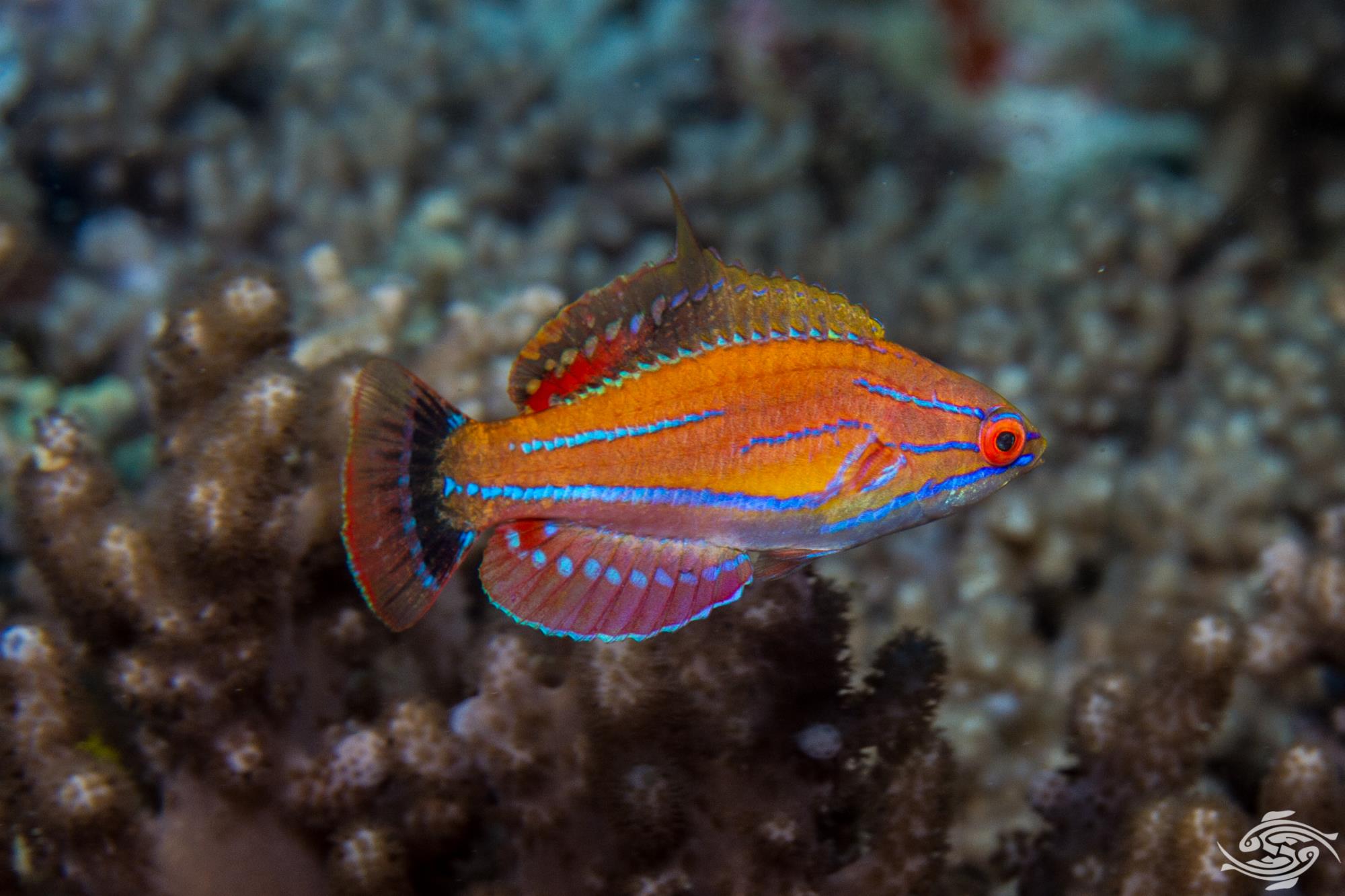Last Updated on February 10, 2023 by Matt
The McCosker’s Flasher Wrasse, Paracheilinus mccoskeri, is one of the most popular and striking of the flasher wrasses. It is brilliantly colored and has a long and beautiful dorsal fin filament.
It is in the same genus as the Royal Flasher Wrasse. Both the scientific name and common name honors the American ichthyologist John E. McCosker, who collected specimens and photographs which were used to describe this species in 1977.
IN THIS ARTICLE
Quick McCosker’s Flasher Wrasse Care Sheet
| McCosker’s Flasher Wrasse Summary | |
| Care Level | Easy |
| Family | Labridae |
| Temperament | Peaceful |
| Diet | Carnivore |
| Origin | Africa, Maldives, and Sumatra |
| Minimum Tank Size | 55 Gallons |
| Color | Yellow, Red, Blue, Orange |
| Size | 3-4 inches (7.5-10 cm) |
| Reef Compatible? | Yes |
| Temperature | 72-78°F (22-25.5°C) |
| Carbonate Hardness | 8-12 dKH |
| Specific Gravity | 1.020-1.025 |
| pH Range | 8.1-8.4 |
Summary
The McCosker’s Flasher Wrasse is a member of the wrasse family Labridae, which includes species such as the well-known cleaner wrasses. The Labridae are typically small and brightly colored, although there are exceptions, such as the huge 2 meter Humphead wrasse.
Paracheilinus mccoskeri is a typical wrasse of the Flasher Wrasse Paracheilinus genus. It is small, colorful, and brilliant for fishkeeping. There are currently 20 species of Flasher Wrasse recognized, which includes the Royal flasher wrasse, Paracheilinus angulatus, and the Carpenter’s flasher wrasse, Paracheilinus carpenteri.
The McCosker’s Flasher Wrasse is native to the Indian Ocean, from Thailand, Northern SUmatra, and the Maldives to Eastern Africa. Typically they are found on sheltered coral reef ecosystems from 5-40 meters in depth. They will be seen generally towards the base of the reef, where it is most sheltered.
The water conditions they require in the home aquarium are the same, or very similar, to the typical reef tank setup. These conditions are a temperature range of 72-78°F, a carbonate hardness of 8-12 dKH, a specific gravity of 1.020-1.025, and a pH range of 8.1-8.4.
As long as the conditions are kept within these ranges there won’t be any issues at all! Make sure you have an aquarium heater and thermometer to maintain the temperature, and you use an alkalinity buffer to maintain the appropriate carbonate hardness and pH. Regular water changes should be done to maintain conditions; water changes can be made easier using a product like the Python water changer. If you are using a RODI water system for water changes, then ensure you use aquarium salt to maintain the specific gravity. They also need a protein skimmer and filtration system to ensure clean water.
McCosker’s Flasher Wrasse are carnivorous fish. They are easy to keep in a home aquarium as they can easily be introduced and acclimatized to a generalized and indiscriminate carnivorous diet. They feed on zooplankton in their natural reef habitat, so live food such as brine shrimp and mysis shrimp are great for them. However they will leave invertebrates in a fish tank be, and will not eat or nibble at coral.
Appearance
The McCosker’s Flasher Wrasse displays sexual dichromatism and dimorphism. This means that the males are more colorful and slightly larger than the females. As is typical of the wrasse family, McCosker’s Flasher Wrasse are protogynous hermaphrodites. This means that they are all born female, and change sex to male when the dominant male dies.
Juvenile McCosker’s Flasher Wrasse possess an orange body with three purple lines starting at the nose, across the eye, and stopping before the gills. The eye is bright red, with a white flash across the top. More purple stripes, usually two, start behind the gills and extend towards the caudal fin. One is usually unbroken and one is shorter. There is also another purple line which runs the length of the fish under the dorsal fin.
As the juveniles mature into adult females the coloration of the body deepens to a pink color, and the purple lines turn to a brilliant iridescent blue. The white mark seen above the eye in juveniles will fade away.
Females and juvenile McCosker’s Flasher Wrasses are beautiful in their own right, but the real magic happens once they mature into a male. The males are beautiful fish and are incredibly popular as aquarium fish.
When a fish changes sex to male, some radical changes occur. Their body changes color to a bright orange, and the caudal, dorsal, and anal fins grow significantly larger. The tenth spine of the dorsal fin grows significantly and becomes a protruding filament. In initial phase males, or sub-adults, the changes mostly stop with the fin enlargement, with some coloration being seen on the fins. The stripes across their bodies are a darker orange color than their bodies.
However once the males mature into terminal phase full adults, or super-males, the dorsal, caudal, and anal fins gain significant coloration. The dorsal fin develops a deep red patch on the lower back portion, and iridescent blue spots also appear at the base and along the middle.
The large anal fin is yellow at the base and deep red at the outer part, split with a line of iridescent blue spots. The caudal fin is a pale yellow/orange color and has a line of red through it. This line can also be blue. Depending on the color variation, there may or may not be a bar of black across the base of the caudal fin. Male McCosker’s Flasher Wrasse with this black bar are called black fin males.
The three lines on the head and lines down the body become iridescent blue as well.
Behavior and Diet
Like all flasher wrasse, the male McCosker’s Flasher Wrasse also displays the trademark flashing behavior.
Flashing behavior is designed to attract the attention of females, so McCosker’s Flasher Wrasse should be kept in a group of one male and multiple females to maximize the likelihood of flashing behavior.
During breeding times, the male will dart out into the water column and shake their fins, showing off their striking colors. They will be more vibrant during this time; flasher wrasses can actually change their colors depending on situation and mood. During the flashing sequence they will make their colors more vibrant and so ‘flash’ their fins and colors at the females.
Females and juveniles are much more skittish than males, and so prefer plenty of hiding places.
McCosker’s Flasher Wrasse also display some burrowing behavior, so having a soft sand substrate will help to emulate the natural environment and make them feel a lot more comfortable.
On the reef they can be seen darting above corals to eat small planktonic animals called zooplankton. Therefore they will love being given live foods such as mysis or brine shrimp to eat. The nutrition content of these shrimp will also help their colors to be as bold and bright as they can be. However they will also happily eat basic marine pelleted and flaked foods. Ideally a mixture of live and frozen food, and high quality pellet and flake food should be given.
Compatibility and Tank Mates
Like all the flasher wrasses, the McCosker’s Flasher Wrasse should be kept in a group of one male with a harem of females. One male to four or five females is good to emulate how they are naturally found.
They aren’t an aggressive species and won’t eat invertebrates or bite coral. Therefore they are total reef safe fish and can be kept with any hard or soft coral, sponges, invertebrates such as mollusks and echinoderms, and fish.
You should avoid housing them with larger aggressive fish, or known fin-biters. The males especially, with their long dorsal fin filament, shouldn’t be exposed to biting fish.
McCosker’s Flasher Wrasse should be housed in a saltwater tank of minimum 55 gallons. To make them feel fully comfortable they should be kept in a tank setup with corals, sponges, and soft sand sediment. On their native reefs they are found near the sea floor, so ensuring that they have a natural benthic environment is key.
Conclusion
The McCosker’s Flasher Wrasse is a brilliant reef fish for medium to large saltwater tanks of 55 gallons or over.
The long fins of the male are very impressive, and in the correct LED lighting they are absolutely stunning visually. The flashing display that the males perform makes for incredible viewing in a reef tank environment.
They are easy to keep and care for, and are very hardy. They are also very unfussy eaters, though they do well given live and frozen food occasionally.
Let us know in the comments if you have this amazing species in your tank setup, and how they are getting on!
Featured Image Photo Credit: Alan Sutton (Seaunseen)







